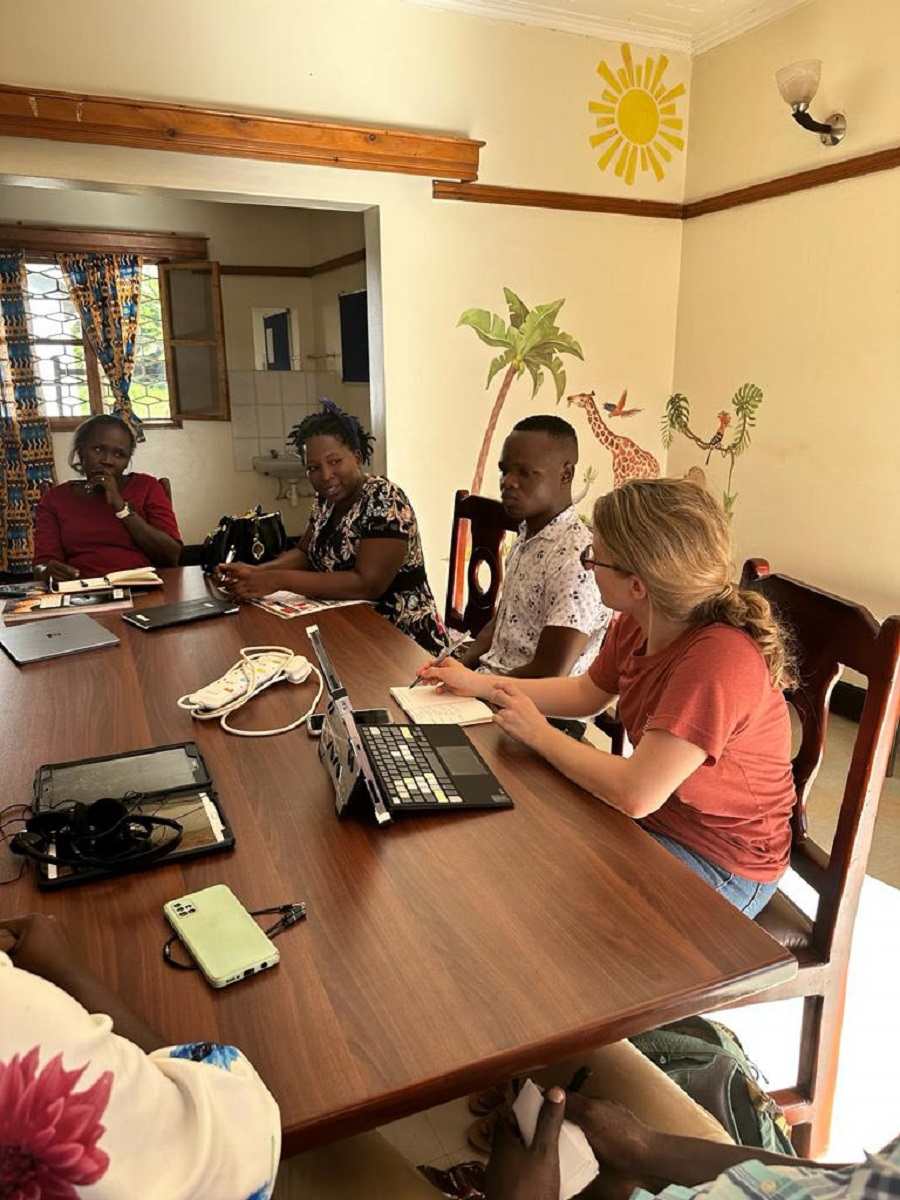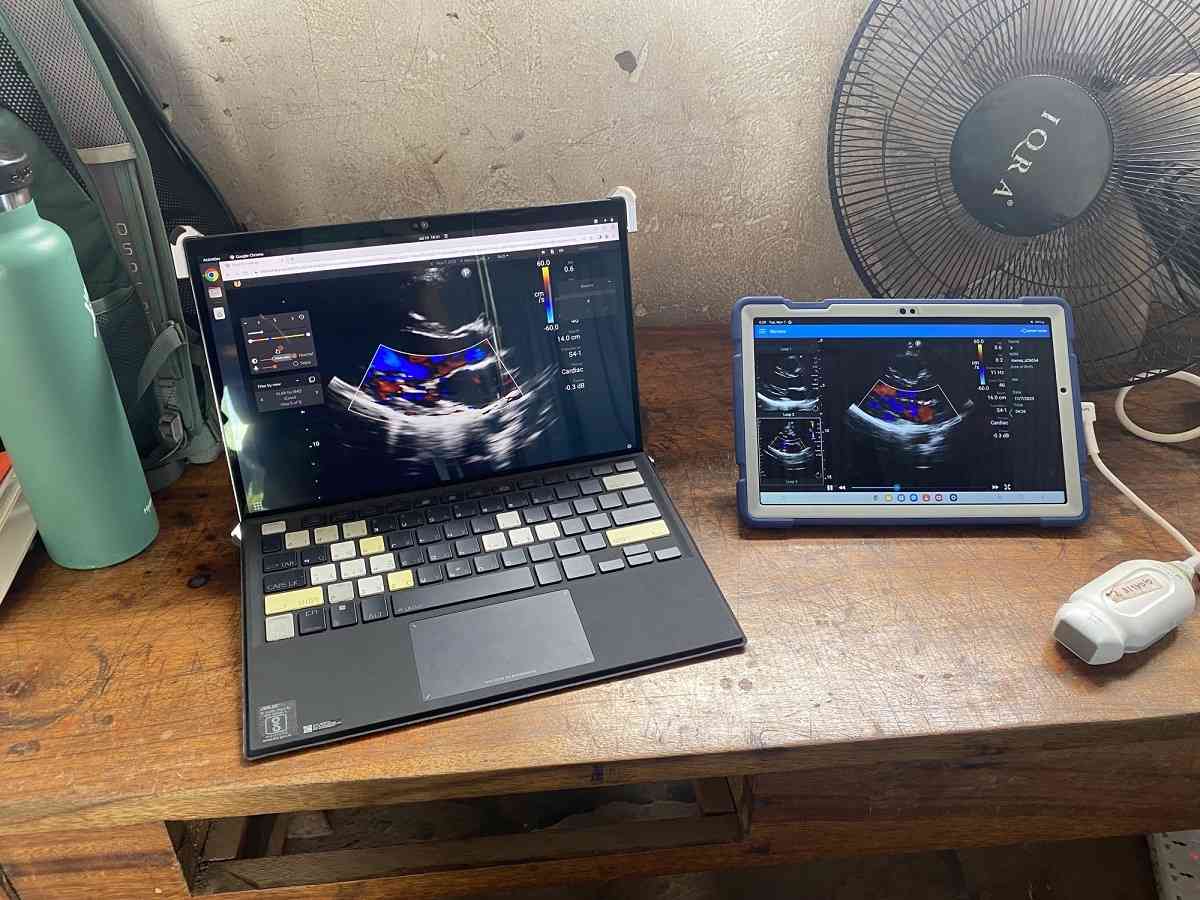
Kelsey Brown, right, works with the Ugandan team of nurses and case managers who will use the AI device to scan for rheumatic heart disease in Lira, Uganda.
11:39 JST, January 17, 2024
When Kelsey Brown met Mohammed, the 15-year-old Ugandan boy looked terribly worried. He was in the late stages of rheumatic heart disease, which kills about 400,000 people a year worldwide. His scheduled heart surgery to address the illness had been postponed a day.
By this point, fluid that backed up from Mohammed’s heart into his lungs made it so hard to breathe that he had to sleep sitting upright. Brown, a cardiology fellow at Children’s National Hospital in Washington, assumed that he was anxious about undergoing the surgery. But Mohammed told her that he was not scared to face the procedure.
“He was most nervous that his surgery would be canceled and his heart would not be repaired,” Brown said, noting a startling contrast to children in the United States whose understandable fear is the surgery itself.
Now, in an advance that shows the potential of artificial intelligence to aid medicine, researchers at Children’s National have developed a new AI-powered tool for diagnosing rheumatic heart disease long before a patient needs surgery. Collaborating with staff at the Uganda Heart Institute, the team designed a system that will allow trained nurses to screen and diagnose children early on, when they can still be treated with penicillin for less than $1 a year. Early treatment could save thousands from having to undergo surgery.
“We are focusing on a dramatically neglected global health issue that causes major [death and disease],” said Craig A. Sable, head of the global health program at Children’s National and one of the authors of a paper describing the AI tool in the Journal of the American Heart Association.
Sable, who has made more than 40 trips to Uganda to care for children, said that on his most recent trip in November, he performed eight or nine heart surgeries a week but observed that there were 1,500 children on a national waiting list for the procedure.
“Only a quarter will get the surgery before they die,” he said.
A largely preventable illness, rheumatic heart disease results from the cumulative toll of repeated bouts of rheumatic fever, which is caused by bacteria called group A Streptococcus. The bacterial group, considered the fifth most lethal pathogen in the world, causes an estimated 600 million people each year to contract strep throat.
A minority of those infected get rheumatic heart disease, which results from an abnormal immune response that damages the heart and its valves. About 5 to 10 percent of people are estimated to have a genetic predisposition to this immune response. But environmental factors, such as poor and crowded living conditions, also play a role.
Often children show their first symptoms of the disease between the ages of 8 and 10. It can be detected early with an ultrasound of the heart, called an echocardiogram. The problem is that countries such as Uganda have too few cardiologists to interpret the images, making widespread screening unfeasible. As a result, the disease often goes undetected in its earliest stages.
“The child doesn’t know [they have] it. The parents don’t know it,” Brown said. “If they go to the doctor, the doctor wouldn’t hear it.”
Rheumatic heart disease plagues poverty-stricken countries such as Uganda, where it afflicts between 2 and 3 percent of all children. These countries are home to many different strains of the bacteria, and children often experience repeated infections. The condition worsens with each new bout.
Though the disease is no longer a significant problem in the United States, it was as recently as the 1940s and 1950s, as Sable knows all too well. He was a teenager when his grandmother died of complications from rheumatic heart disease and emphysema.
“It was the number-one cause of cardiac death in the United States in the first half of the 20th century,” Sable said. “Over 100,000 military members were excluded from the Army for World War II because they had rheumatic fever or rheumatic heart disease.”
The use of artificial intelligence in health care has been exploding since 2018, when the Food and Drug Administration approved the first independent AI-based diagnostic tool ― known as the IDx-DR ― to screen for diabetic retinopathy, a serious eye condition that can develop in people with diabetes. A little more than five years later, there are almost 700 FDA-approved artificial intelligence and machine learning-enabled medical devices.
While echocardiogram machines in a hospital weigh about 500 pounds and cost $250,000, the equipment developed by the Children’s National team would be lightweight and cost between $2,000 and $5,000. A Singapore-based company, Us2.ai, is developing software with the team’s algorithm, which was trained using more than 1,000 echocardiograms.
The algorithm can interpret images in seconds, classifying them either as “normal” or as “consider rheumatic heart disease.” In tests on the echocardiograms of more than 500 patients, the new tool interpreted images with an accuracy rate close to 90 percent.
“The value of AI is extraordinary if you can use it to improve the accuracy of images,” said Chris Longenecker, director of the Global Cardiovascular Health Program at the University of Washington who was not involved in the study. He said artificial intelligence will make ultrasound a particularly powerful tool because “you can take it to the most remote corners of a low-income country.”
Longenecker said AI may also help doctors learn more about the critical characteristics of rheumatic heart disease.
“AI can work like a doctor and potentially add something to what a doctor does,” said Pooneh Roshanitabrizi, a staff scientist at Children’s National who developed the new algorithm for interpreting echocardiograms with Marius Linguraru, principal investigator in the hospital’s Sheikh Zayed Institute for Pediatric Surgical Innovation.
Researchers from Children’s National said the new screening system is being tested and improved based on up to 200,000 pediatric cases in Uganda. Each child in the program is screened according to the current standard, in which trained nurses interpret the echocardiograms on their own.
The vast majority of data from the 200,000 cases will then be used to train and improve the algorithm.
If the new screening tool receives approval from Ugandan and U.S. regulators, each nurse would be provided with a probe about the size of a computer mouse – to generate images of the heart – and a tablet outfitted with the AI component.
Cases flagged as possible rheumatic heart disease would be followed up with an examination by a cardiologist. The cardiologist visits could be conducted using telemedicine rather than requiring travel to or from remote areas.
Shelby Kutty, director of pediatric congenital cardiology at Johns Hopkins Children’s Center, who was not involved in the project, said that while similar research has been done for adult heart disease, “work in pediatric heart disease has been relatively limited.”
“Overall I think this is very encouraging work,” Kutty added. “I think the field is well on its way.”

A handheld echo device and ultrasound probe, right, sit next to the portable AI device developed by Children’s National and Us2.ai during its initial testing phase in northern Uganda.
"News Services" POPULAR ARTICLE
-

American Playwright Jeremy O. Harris Arrested in Japan on Alleged Drug Smuggling
-

Taiwan President Shows Support for Japan in China Dispute with Sushi Lunch
-

Japan’s Nikkei Stock Average as JGB Yields, Yen Rise on Rate-Hike Bets
-

Japan’s Nikkei Stock Average Licks Wounds after Selloff Sparked by BOJ Hike Bets (UPDATE 1)
-

Japanese Bond Yields Zoom, Stocks Slide as Rate Hike Looms
JN ACCESS RANKING
-

Japan’s Hopes for Seafood Exports Shot Down in China Spat
-

Keidanren Chairman Yoshinobu Tsutsui Visits Kashiwazaki-Kariwa Nuclear Power Plant; Inspects New Emergency Safety System
-

Japan to Charge Foreigners More for Residence Permits, Looking to Align with Western Countries
-

Japan Exports Rise in October as Slump in U.S. Sales Eases
-

Niigata Gov. to OK Restart of N-Plant; Kashiwazaki-Kariwa May Be Tepco’s 1st Restarted Plant Since 2011






















